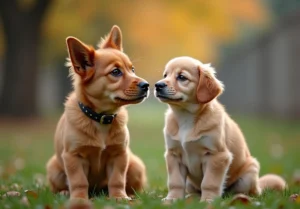Cats are known for their independent and often aloof nature, but when it comes to interrupting other dogs, they can be quite assertive. Have you ever wondered why cats feel the need to insert themselves into situations involving other dogs? Let’s explore the reasons behind this curious behavior.
Cats interrupt other dogs for a variety of reasons, including asserting dominance, seeking attention, or simply out of curiosity. Let’s take a closer look at the motivations behind this behavior.
1. Why do cats interrupt dogs during playtime?
Have you ever wondered why cats often feel the need to interrupt dogs while they are in the middle of playtime? It turns out, this behavior could stem from a few different reasons. One common explanation is that cats are simply asserting their dominance over the situation. By interrupting the dogs during play, cats are establishing themselves as the ones in control. Additionally, cats may interrupt dogs as a way to seek attention or to redirect the focus onto themselves. They might feel left out or jealous of the interaction between the dogs, prompting them to intervene.
Interestingly, another reason cats interrupt dogs during playtime could be due to their instinctual prey drive. Cats are natural hunters, and when they see the dogs engaging in energetic play, they may perceive it as a form of prey-like behavior. This can trigger their hunting instincts, causing them to swoop in and interrupt the play session.
Overall, cats interrupting dogs during playtime can be a combination of asserting dominance, seeking attention, and responding to their natural instincts as hunters.
2. What are some common signs of cat interruption?
When it comes to cat interruptions during playtime, there are several telltale signs to watch out for. One common behavior is the cat stalking the dogs from a distance, eyeing them with intense focus. This can be a precursor to the cat pouncing or swatting at the dogs to interrupt their play.
Another sign of cat interruption is vocalization. Cats may meow loudly or make other vocalizations to get the attention of the dogs and disrupt their play session. This can be a clear indicator that the cat is not happy with the current situation and is looking to intervene.
Furthermore, cats may exhibit body language cues such as an arched back, raised fur, or a twitching tail when they are about to interrupt dogs. These physical signs can indicate that the cat is feeling agitated or ready to engage with the dogs.
By recognizing these common signs of cat interruption, you can better understand when your cat is about to interfere with your dog’s playtime and take steps to manage the situation effectively.
For more insights on cat and dog behaviors, you can check out this resource on PetMD.
3. How do dogs typically react to cat interruptions?
When a cat interrupts a dog, the dog’s reaction can vary. Some dogs may see it as a playful interaction and engage with the cat in a friendly manner. However, other dogs may feel threatened or territorial and might respond aggressively towards the cat. It’s important to understand your dog’s individual personality and behavior when it comes to interactions with cats. Training and socialization can also play a significant role in how a dog responds to cat interruptions. Positive reinforcement and rewarding calm behavior around cats can help create a harmonious environment between the two animals.
4. Can cat interruptions lead to conflict between cats and dogs?
Cat interruptions in dog-related activities can sometimes lead to conflict between cats and dogs in a household. Cats may interrupt playtime or attention-seeking behavior by dogs, which can result in frustration or even aggression from the dog. To prevent conflicts, it’s crucial to provide each pet with their space and resources. Creating separate areas for cats and dogs to retreat to can minimize the likelihood of confrontations. Additionally, supervising interactions between cats and dogs and positively reinforcing calm behavior can help mitigate potential conflicts.
Additional Insight:
- Establish Clear Boundaries: Setting clear boundaries for both cats and dogs can help prevent misunderstandings and conflicts. Designate specific areas in the house for each pet, including separate feeding and sleeping areas, to minimize the chances of territorial disputes. Regular training sessions focusing on impulse control and obedience commands can also reinforce boundaries and promote mutual respect between cats and dogs.
Remember, understanding the dynamics between cats and dogs in your household and proactively addressing any potential conflicts can foster a peaceful coexistence between these beloved pets.
5. What are some strategies to minimize cat interruptions?
When living in a multi-pet household, it’s essential to establish boundaries to minimize cat interruptions during interactions with dogs. One effective strategy is to create separate spaces for each pet, such as providing a designated dog area and a cat-only zone. This helps reduce the chances of cats feeling the need to interrupt dog activities.
Another helpful tip is to provide enrichment activities for both cats and dogs separately. Keeping them mentally stimulated can prevent cats from seeking attention from dogs out of boredom. Additionally, regular exercise and playtime for each pet can help burn off excess energy, reducing the likelihood of disruptive behavior.
Consistent training and positive reinforcement play a crucial role in managing cat interruptions. Teaching both cats and dogs basic commands like “stay” or “leave it” can help prevent unwanted interactions. Rewarding good behavior with treats or praise can reinforce positive habits and discourage interruptions.
Overall, fostering a harmonious environment through clear boundaries, mental stimulation, and consistent training can greatly reduce cat interruptions and promote peaceful coexistence among pets.
Additional Tip: Providing vertical space for cats, such as cat trees or shelves, can give them a safe retreat to observe dogs from a distance, reducing the urge to interrupt their activities.
6. Are there specific breeds of cats that are more prone to interrupting dogs?
While there is no definitive research on specific cat breeds that are more prone to interrupting dogs, certain personality traits commonly found in breeds can contribute to this behavior. For instance, highly social and curious breeds like Siamese, Maine Coon, or Abyssinian cats may be more inclined to seek interaction with dogs.
Additionally, individual temperament and past experiences play a significant role in a cat’s behavior towards dogs. Cats that have been socialized with dogs from a young age are more likely to tolerate their presence and interact positively. Conversely, cats with a history of negative encounters with dogs may be more prone to interrupt or disrupt their activities.
It’s essential to consider each cat as an individual and address their specific needs and preferences when managing interactions with dogs. By understanding your cat’s personality and providing appropriate socialization and enrichment, you can create a harmonious relationship between cats and dogs in your household.
For further information on understanding cat behavior and interactions with dogs, check out this resource.
7. How can pet owners encourage positive interactions between cats and dogs?
Creating a peaceful coexistence between cats and dogs requires patience and understanding. Begin by slowly introducing the animals in a controlled environment, allowing them to sniff and observe each other from a safe distance. Reward good behavior with treats and praise to reinforce positive interactions. Provide separate spaces for each pet to retreat to when needed, ensuring they have their own food, water, and resting areas. Supervise their interactions closely, stepping in to redirect any negative behavior. Engage them in joint activities like playing with toys to foster a sense of unity. Remember, consistency is key in establishing a harmonious relationship between your furry friends.
8. What are some fun facts about cat behavior that may explain their tendency to interrupt dogs?
Cats have a unique hunting instinct that drives them to stalk and pounce on moving objects – including unsuspecting dogs. This behavior stems from their ancestors, who were solitary hunters in the wild. Their curiosity knows no bounds, leading them to investigate anything new or unfamiliar in their environment, which may include interrupting a dog’s activities. Cats are territorial creatures, often seeking to assert their dominance by asserting their presence around other pets. Their independent nature makes them less likely to seek approval from other animals, leading to assertive behavior. Knowing these interesting facts about cat behavior can shed light on why they may interrupt dogs and help pet owners navigate their interactions more effectively.
Alex, a passionate animal lover, has experience in training and understanding animal behavior. As a proud pet parent to two dogs and three cats, he founded AnimalReport.net to share insights from animal experts and expand his knowledge of the animal kingdom.




